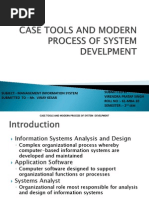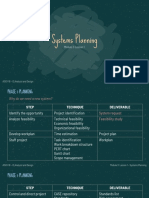Life Cycle Development Model
Life Cycle Development Model
Uploaded by
api-256677991Copyright:
Available Formats
Life Cycle Development Model
Life Cycle Development Model
Uploaded by
api-256677991Original Title
Copyright
Available Formats
Share this document
Did you find this document useful?
Is this content inappropriate?
Copyright:
Available Formats
Life Cycle Development Model
Life Cycle Development Model
Uploaded by
api-256677991Copyright:
Available Formats
5/7/2014
1
Systems Analysis and Design, 7e
Kendall & Kendall
2
Know the steps of the SDLC as they relate to HCI and how to
apply them to a real system
Understand what CASE tools are and how they help a
systems analyst
Explore other methodologies such as object-oriented
systems design and prototyping
Kendall & Kendall 1-2
Fuels business and can be the critical factor in
determining the success or failure of a
business
Needs to be managed correctly
Managing computer-generated information
differs from handling manually produced
data
Kendall & Kendall 1-3
5/7/2014
2
Phases in the systems development life cycle
as they relate to Human-Computer
Interaction (HCI) factors
Computer-Aided Software Engineering
(CASE) tools
Kendall & Kendall 1-4
The systems development life cycle is a
phased approach to solving business
problems
Developed through the use of a specific cycle
of analyst and user activities
Each phase has unique user activities
Kendall & Kendall 1-5
Kendall & Kendall 1-6
5/7/2014
3
The demand for analysts who are capable of
incorporating HCI into the systems
development process keeps increasing, as
companies begin to realize that the quality of
systems and the quality of work life can be
improved by taking a human-centered
approach at the outset of a project
Kendall & Kendall 1-7
Activity:
Interviewing user management
Summarizing the knowledge obtained
Estimating the scope of the project
Documenting the results
Output:
Feasibility report containing problem definition and
objective summaries from which management can make a
decision on whether to proceed with the proposed project
Kendall & Kendall 1-8
Activity:
Interviewing
Sampling and investing hard data
Questionnaires
Observe the decision makers behavior and environment
Prototyping
Learn the who, what, where, when, how, and why of the current
system
Output:
Analyst understands how users accomplish their work when
interacting with a computer; and begin to know how to make the new
system more useful and usable. The analyst should also know the
business functions and have complete information on the people,
goals, data and procedure involved
Kendall & Kendall 1-9
5/7/2014
4
Activity:
Create data flow diagrams
Complete the data dictionary
Analyze the structured decisions made
Prepare and present the system proposal
Output:
Recommendation on what, if anything, should be
done
Kendall & Kendall 1-10
Activity:
Design procedures for data entry
Design the human-computer interface
Design system controls
Design files and/or database
Design backup procedures
Output
Model of the actual system
Kendall & Kendall 1-11
Activity:
System analyst works with programmers to develop any original
software
Works with users to develop effective documentation
Programmers design, code, and remove syntactical errors from
computer programs
Document software with help files, procedure manuals, and Web
sites with Frequently Asked Questions
Output:
Computer programs
System documentation
Kendall & Kendall 1-12
5/7/2014
5
Activity:
Test the information system
System maintenance
Maintenance documentation
Output:
Problems, if any
Updated programs
Documentation
Kendall & Kendall 1-13
Activity:
Train users
Analyst plans smooth conversion from old system
to new system
Review and evaluate system
Output:
Trained personnel
Installed system
Kendall & Kendall 1-14
Kendall & Kendall 1-15
5/7/2014
6
Maintenance is performed for two reasons
Removing software errors, and
Enhancing existing software
Over time the cost of continued maintenance
will be greater than that of creating an entirely
new system. At that point it becomes more
feasible to perform a new systems study
Kendall & Kendall 1-16
Kendall & Kendall 1-17
Traditional systems development life
cycle
CASE systems development life cycle
Object-Oriented Systems Analysis and
Design
Kendall & Kendall 1-18
5/7/2014
7
CASE tools are productivity tools for systems
analysts that have been created explicitly to
improve their routine work through the use of
automated support
Reasons for using CASE tools
Increasing Analyst Productivity
Improving Analyst-User Communication
Integrating Life Cycle Activities
Accurately Assessing Maintenance Changes
Kendall & Kendall 1-19
Upper CASE tools perform analysis and
design
Lower CASE tools generate programs
from CASE design
Integrated CASE tools perform both
upper and lower CASE functions
Kendall & Kendall 1-20
Create and modify the system design
Help in modeling organizational
requirements and defining system
boundaries
Can also support prototyping of screen
and report designs
Kendall & Kendall 1-21
5/7/2014
8
Lower CASE tools generate computer
source code from the CASE design
Source code is usually generated in
several languages
Kendall & Kendall 1-22
Kendall & Kendall 1-23
Alternate approach to the structured approach of the
SDLC that is intended to facilitate the development of
systems that must change rapidly in response to
dynamic business environments
Analysis is performed on a small part of the system
followed by design and implementation. The cycle
repeats with analysis, design and implementation of the
next part and this repeats until the project is complete
Kendall & Kendall 1-24
5/7/2014
9
Agile approach
Prototyping
ETHICS
Project champion
Soft Systems Methodology
Multiview
Kendall & Kendall 1-25
Information is a key resource
Systems analysts deal with many types of information
systems
Integration of traditional systems with new
technologies
Roles and qualities of the systems analyst
The systems Development Life Cycle
CASE tools
Alternatives to structured analysis and design and to the
SDLC
Kendall & Kendall 1-26
You might also like
- The Impact of Wage On Employee ProductivityDocument6 pagesThe Impact of Wage On Employee ProductivityImelda Arreglo-Agripa70% (10)
- Rotating QuestionsDocument5 pagesRotating QuestionsSud100% (4)
- A Farewell To Alms Clark en 9377.simpleDocument10 pagesA Farewell To Alms Clark en 9377.simpleNathan LaingNo ratings yet
- Systems Analysis and Design in A Changing World, Fifth EditionDocument22 pagesSystems Analysis and Design in A Changing World, Fifth EditiontalhaadnanNo ratings yet
- System Analysis and Design - An Object Oriented Approach With UML Chapter 1Document8 pagesSystem Analysis and Design - An Object Oriented Approach With UML Chapter 1Jared TanNo ratings yet
- Worksheet 3 - Phases of SDLCDocument2 pagesWorksheet 3 - Phases of SDLChaziq raoNo ratings yet
- Life Cycle Development ModelDocument26 pagesLife Cycle Development Modelapi-256677991No ratings yet
- Assuming The Role of The Systems AnalystDocument41 pagesAssuming The Role of The Systems AnalystAngelique Vibar De CilloNo ratings yet
- Information System Development Methodology: Instructor: Hendrik Course: Sistem InformasiDocument39 pagesInformation System Development Methodology: Instructor: Hendrik Course: Sistem InformasiNaufal MubarakNo ratings yet
- CASE Tools - PPTDocument29 pagesCASE Tools - PPTsbr11No ratings yet
- The Systems Development Environment: © 2008 by Prentice HallDocument45 pagesThe Systems Development Environment: © 2008 by Prentice HallYazanAlomariNo ratings yet
- Nico Assignment SADDocument16 pagesNico Assignment SADNicolas Lich MatuenyNo ratings yet
- Systems Analysis and Design by KevalDocument227 pagesSystems Analysis and Design by KevalR!0100% (1)
- The Fun Filled World of Methodologies: by Eric Delisle & Sasan RastegarlariDocument28 pagesThe Fun Filled World of Methodologies: by Eric Delisle & Sasan RastegarlarivishwakiranNo ratings yet
- Chapter 3-SDLC and MethodologiesDocument21 pagesChapter 3-SDLC and Methodologies07dkarkeNo ratings yet
- Lecture1 - Systems, Rules, and Development MethodologiesDocument49 pagesLecture1 - Systems, Rules, and Development MethodologiesNurhaini ZulvanaNo ratings yet
- Systems Development Life Cycle & Prototyping: (Methodologies)Document17 pagesSystems Development Life Cycle & Prototyping: (Methodologies)Tara TrotterNo ratings yet
- The Systems Development EnvironmentDocument6 pagesThe Systems Development EnvironmentAhimbisibwe BakerNo ratings yet
- Chapter 3-SDLCDocument6 pagesChapter 3-SDLCShaggYNo ratings yet
- The Systems Development Life CycleDocument8 pagesThe Systems Development Life CycleRichelle PolicarpioNo ratings yet
- Assuming The Role of The Systems Analyst: Information System Analysis and Design Dr. Patrick D. Cerna MSC AICM ProgramDocument38 pagesAssuming The Role of The Systems Analyst: Information System Analysis and Design Dr. Patrick D. Cerna MSC AICM ProgramPatcernaNo ratings yet
- Assuming The Role of The Systems AnalystDocument7 pagesAssuming The Role of The Systems Analystapi-256677991No ratings yet
- HostelDocument48 pagesHostelNaveen Jaswal75% (4)
- Chapter+4+Revision+notes - PDF ICT2621Document5 pagesChapter+4+Revision+notes - PDF ICT2621mmasalekNo ratings yet
- Assuming The Role of The Systems Analyst: Systems Analysis and Design Kendall and Kendall Fifth EditionDocument37 pagesAssuming The Role of The Systems Analyst: Systems Analysis and Design Kendall and Kendall Fifth EditionAnu MohanNo ratings yet
- The Systems Development Environment: Jeffrey A. Hoffer Joey F. George Joseph S. ValacichDocument29 pagesThe Systems Development Environment: Jeffrey A. Hoffer Joey F. George Joseph S. ValacichJohn Natividad100% (1)
- Se Practical FileDocument58 pagesSe Practical FileDivya Gupta100% (1)
- Manager Decision MakingDocument6 pagesManager Decision MakingTakeru ShinjiroNo ratings yet
- Systems Analysis and DesignDocument29 pagesSystems Analysis and DesignvirusyadavNo ratings yet
- SDLCDocument32 pagesSDLCNijith NTNo ratings yet
- Information Systems Analysis OverviewDocument13 pagesInformation Systems Analysis Overviewabhi7219No ratings yet
- Chapter 4 System Analysis and Design (SAD) NoteDocument6 pagesChapter 4 System Analysis and Design (SAD) NoteAden Kheire MohamedNo ratings yet
- Systems Analysis and Design: The Big Picture: Computers:Tools For An Information AgeDocument51 pagesSystems Analysis and Design: The Big Picture: Computers:Tools For An Information AgeMuh Fauzi NatsirNo ratings yet
- Homework 3Document10 pagesHomework 3Preet AroraNo ratings yet
- Software Development Practices: 12/08/2021 S.G.NambuwasamDocument42 pagesSoftware Development Practices: 12/08/2021 S.G.Nambuwasamlankasiriyadownload100% (1)
- To Software Development Life CycleDocument23 pagesTo Software Development Life CycleMansi GuptaNo ratings yet
- Week 1netwrokDocument33 pagesWeek 1netwrokMohammed QaderNo ratings yet
- SAAD Lecture II - SDLCDocument100 pagesSAAD Lecture II - SDLCKisyenene JamusiNo ratings yet
- Chap 01Document37 pagesChap 01duarte1judeNo ratings yet
- System Development Life CycleDocument68 pagesSystem Development Life Cycleceoayushkv1No ratings yet
- Object Oriented System Analysis and Design: By: Azmeraw DessalegnDocument50 pagesObject Oriented System Analysis and Design: By: Azmeraw DessalegnChali shiferaNo ratings yet
- Manyindo Water Fall Methord of Project DevelopmentDocument6 pagesManyindo Water Fall Methord of Project DevelopmentStevenNo ratings yet
- File Tracking SystemDocument5 pagesFile Tracking SystemAlad Manoj Peter100% (1)
- System Development Life CycleDocument3 pagesSystem Development Life Cyclesw drNo ratings yet
- Obrien13e Chap010Document82 pagesObrien13e Chap010Sohail Merchant100% (1)
- Mis Module IIDocument37 pagesMis Module IIsyamantagarudNo ratings yet
- IFT 103 Module 8 and 9Document31 pagesIFT 103 Module 8 and 9nwekenile18No ratings yet
- Subject:-Management Information System Submitted To: - Mr. Vinay Kesar Submitted By: - Virendra Pratap Singh ROLL NO: - 61-MBA-10 Semester: - 2Document18 pagesSubject:-Management Information System Submitted To: - Mr. Vinay Kesar Submitted By: - Virendra Pratap Singh ROLL NO: - 61-MBA-10 Semester: - 2Virendra Pratap SinghNo ratings yet
- Chapter 10 RevisionDocument7 pagesChapter 10 Revisiontaariqc2000No ratings yet
- Different MethodologiesDocument11 pagesDifferent Methodologiesian uzumakiNo ratings yet
- Systems Development: Phases, Tools, and TechniquesDocument59 pagesSystems Development: Phases, Tools, and TechniquesSharifah RubyNo ratings yet
- SDLC and SE ConceptsDocument99 pagesSDLC and SE ConceptsAnkit ShuklaNo ratings yet
- KMBIT05 - SAD - Unit 3 - Requirement Specification - Alok Singh - Sem4Document35 pagesKMBIT05 - SAD - Unit 3 - Requirement Specification - Alok Singh - Sem4AsHish KasHyapNo ratings yet
- Developing Business/IT SolutionsDocument65 pagesDeveloping Business/IT SolutionsRAMEEZ. ANo ratings yet
- System Analysis and DesignDocument60 pagesSystem Analysis and DesignNathanNo ratings yet
- SAD Chapter OneDocument31 pagesSAD Chapter Onenatnaelabebe2024No ratings yet
- Software Development MethodologyDocument4 pagesSoftware Development MethodologyNasserNo ratings yet
- Unit 5 Software Development, Design and Testing: StructureDocument24 pagesUnit 5 Software Development, Design and Testing: StructureAnonymous bTh744z7E6No ratings yet
- Software Testing Interview Questions You'll Most Likely Be AskedFrom EverandSoftware Testing Interview Questions You'll Most Likely Be AskedNo ratings yet
- Mastering Software Engineering: From Basics to Expert ProficiencyFrom EverandMastering Software Engineering: From Basics to Expert ProficiencyNo ratings yet
- Worksheet Activity 4 Unit 1Document1 pageWorksheet Activity 4 Unit 1api-256677991No ratings yet
- Comparison Matrix WorksheetDocument1 pageComparison Matrix Worksheetapi-256677991No ratings yet
- E-Book ExerciseDocument1 pageE-Book Exerciseapi-256677991No ratings yet
- Assuming The Role of The Systems AnalystDocument7 pagesAssuming The Role of The Systems Analystapi-256677991No ratings yet
- Hypercase ExerciseDocument1 pageHypercase Exerciseapi-256677991No ratings yet
- Book 2Document175 pagesBook 2Shah AasifNo ratings yet
- INVISIHITCH BMW 3 & 4 Series (F30!31!32!33!34-36) Wiring Installation, Invisihitch HarnessDocument4 pagesINVISIHITCH BMW 3 & 4 Series (F30!31!32!33!34-36) Wiring Installation, Invisihitch HarnessNamiq Ş-OvNo ratings yet
- Introduction À l'ETL Et Application Avec Oracle: Data WarehouseDocument64 pagesIntroduction À l'ETL Et Application Avec Oracle: Data WarehouseSirem AmazNo ratings yet
- General Educ ReviewerDocument59 pagesGeneral Educ ReviewerAkmad Ali AbdulNo ratings yet
- Data Types: Shristi Technology LabsDocument13 pagesData Types: Shristi Technology LabsRANJAN RAJNo ratings yet
- Activity 5Document3 pagesActivity 5Sherly Borcena MaculaNo ratings yet
- LF 444Document20 pagesLF 444Glauco Borges BrumNo ratings yet
- Problems 1Document2 pagesProblems 1Laura CotsNo ratings yet
- Une-En 13445-2 2021Document92 pagesUne-En 13445-2 2021iqbarraganNo ratings yet
- Second Language Learning JourneyDocument2 pagesSecond Language Learning JourneyMalakNo ratings yet
- DOC-20240917-WA0008.-pages-2 (2) - Pages-2Document53 pagesDOC-20240917-WA0008.-pages-2 (2) - Pages-2Meenu YadavNo ratings yet
- Set 1 HandoutsDocument11 pagesSet 1 HandoutsPraba KaranNo ratings yet
- Systems Planning To AnalysisDocument17 pagesSystems Planning To AnalysisShierdy Lynn E. NorialNo ratings yet
- Learning Activity 8 Strength of Materials - Compress - 2Document4 pagesLearning Activity 8 Strength of Materials - Compress - 2jay vasquezNo ratings yet
- Modul PsikoedukasiDocument18 pagesModul PsikoedukasiTuthi Farhiyah Alawiyah100% (1)
- Jammu-Kashmir and COVID-19: Subject: MathematicsDocument21 pagesJammu-Kashmir and COVID-19: Subject: MathematicsTejo MukeshNo ratings yet
- Design of Hydraulic Structures Lecture 4Document11 pagesDesign of Hydraulic Structures Lecture 4Suleman FaisalNo ratings yet
- English 7 - Quarter3 - Mod7 - Reacting-on-Public-Forums-and-DiscussionsDocument19 pagesEnglish 7 - Quarter3 - Mod7 - Reacting-on-Public-Forums-and-DiscussionsJoan BedioresNo ratings yet
- Installation Manual LGDocument3 pagesInstallation Manual LGWasim AhmedNo ratings yet
- Learning Episode 4.4Document6 pagesLearning Episode 4.4Rezia Rose PagdilaoNo ratings yet
- Θ Θ F = Bilsinθ F = Bilcosθ F = BilsinθDocument2 pagesΘ Θ F = Bilsinθ F = Bilcosθ F = BilsinθIntiser RahmanNo ratings yet
- Patologi Sosial Dalam Wacana Lagu Karya Slank Pada Album Plur Tahun 2004 Novi Nurcahyanti, Hari Satrijono, Furoidatul HusniahDocument8 pagesPatologi Sosial Dalam Wacana Lagu Karya Slank Pada Album Plur Tahun 2004 Novi Nurcahyanti, Hari Satrijono, Furoidatul HusniahZakiyatul HadiNo ratings yet
- 39B9 LE39B9000 TP - VST59S.PB813 SMv1.0 PDFDocument37 pages39B9 LE39B9000 TP - VST59S.PB813 SMv1.0 PDFhukam pariharNo ratings yet
- C16-Chokes and DegasserDocument68 pagesC16-Chokes and Degasserrezoka100% (1)
- NASA Surface Meteorology and Solar Energy - RETScreen DataDocument2 pagesNASA Surface Meteorology and Solar Energy - RETScreen DataCarlos Isaac Ramirez Velazquez100% (1)
- Entrepreneurs: Project Of: Employability SkillsDocument12 pagesEntrepreneurs: Project Of: Employability SkillsDivyansh SharmaNo ratings yet
- Airtable Marketing Trends Report 2024Document34 pagesAirtable Marketing Trends Report 2024intelligentantoniNo ratings yet





























































































